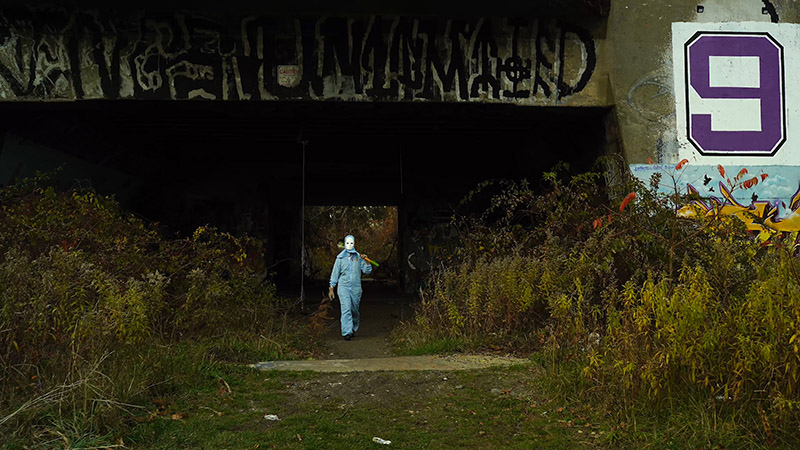15,000 Days
Kingston Gallery • Boston, MA • kingstongallery.com • March 3–28, 2021
Krystle Brown’s three-channel video installation, 15,000 Days, opens with a view of the wake of a boat, bordered on each side by rapidly moving ocean. Water sounds slowly recede, replaced by a low, continuous drone. A central figure with a shovel over the left shoulder, strides toward us from a tunnel beneath a graffitied underpass. Dressed in a blue hazmat suit, wearing a white mask, the figure begins digging in the stony soil of the beach on Peaks Island in Maine.

As the figure methodically excavates a hole within a circle of stones, the camera focuses on each shovelful, thereby slowing down time. Grave-digging comes to mind—a task still often done by hand. A deep female voice intones Brown’s poem, “15,000 Days,” which is also the video’s title, “If I could find a way to make you comfortable.” Yet there is no comfort in the scene. The metal shovel continues to grate against the grainy sand.
This is particularly poignant during the Covid-19 pandemic when graves are dug, and people buried without ceremony. We are also facing a deteriorating planet. Climate change will become permanent in 40 years—15,000 days—unless we intervene. Brown consciously slows time down by the ritualistic pace of the digging, attempting to get us to realize the consequences of our day-to-day actions.
She interweaves the personal and the universal. Watching her father, a gravedigger in his youth, die slowly of a mysterious disease, informs her feelings of the relentless nature of climate change. She asks in her poem, “if the calcium in the great oceans came from coral or from bones tossed overboard,” a reference to numberless climate refugees who have lost their lives at sea.
The entire presentation speaks to Brown’s deep love of humanity, her respect for working-class labor, and her concern for the world that she has inherited. An empty bottle is buried in the earth’s grave. Brown writes, “We may have buried our dead, but we have not buried ourselves.” Significantly, she offers each visitor a small bottle containing Peaks Island sand, a reminder of the preciousness of the earth, and a harbinger of hope.
—B. Amore
